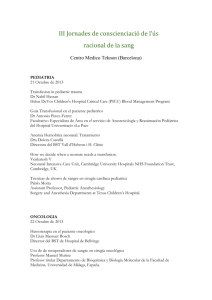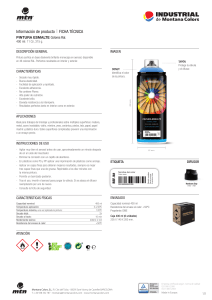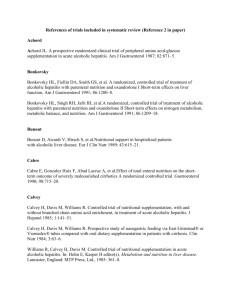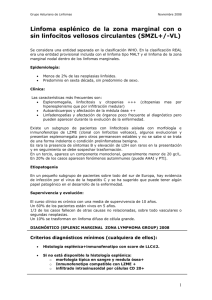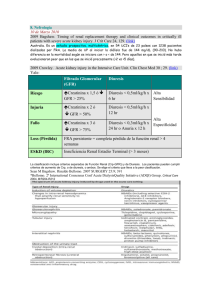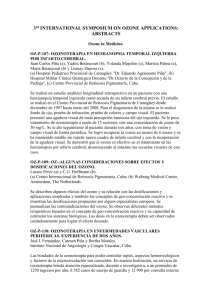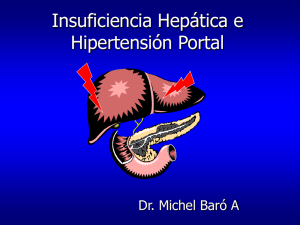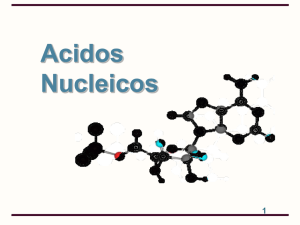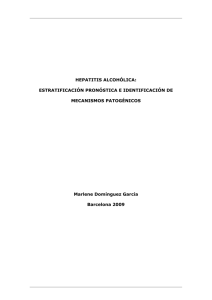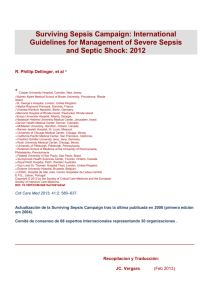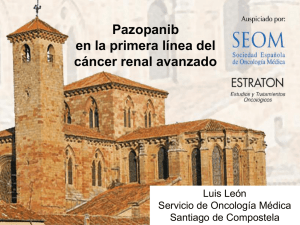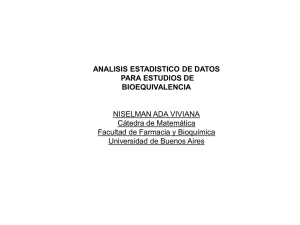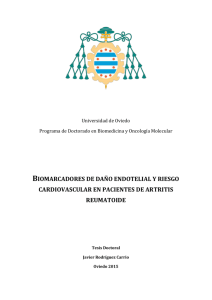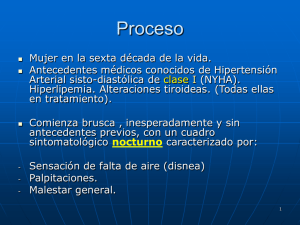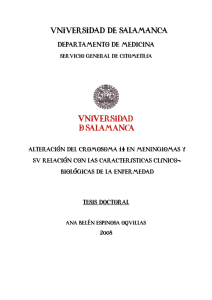(DRV).
advertisement
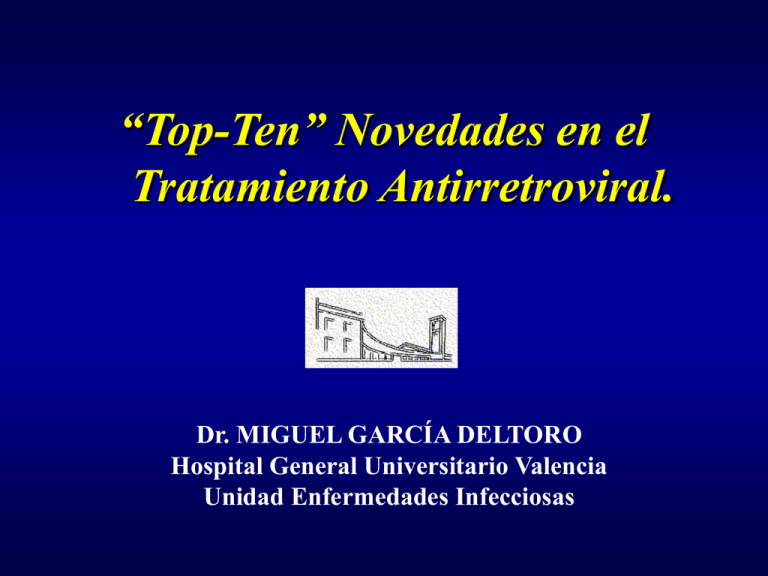
“Top-Ten” Novedades en el Tratamiento Antirretroviral. Dr. MIGUEL GARCÍA DELTORO Hospital General Universitario Valencia Unidad Enfermedades Infecciosas Top Ten Tenis 25 Fármacos antirretrovirales RAL DLV ddC ZDV ddI NVP d4T 3TC TFV ABC EFV ETR FTC ’87 ’88 ’89 ’90 ’91 ’92 ’93 ’94 ’95 ’96 ’97 ’98 ’99 ’00 ’01 ’02 ’03 ’04 ’05 ’06 ’07 NRTI SQV NFV LPV NNRTI DRV FPV PI RTV Inhibidor entrada IDV Ø INTEGRASA ATV APV TPV T-20 25 antirretrovirales aprobados por la FDA MVC DRV ETR MV C RAL Preferred Regimens for Treatment-Naive Pts: DHHS (12/09) DHHS guidelines. Available at: http://www.aidsinfo.nih.gov. Evitar añadir ptes al “carro” de la Multirresistencia y Lipodistrofia .... Y entre todos lo estamos consiguiendo, pero sobre todo por los nuevos fármacos y los “combos”.... Top Ten Novedades Tto ARV…. 1.- DARUNAVIR (DRV). 2.- MARAVIROC (MVC). 3.- RALTEGRAVIR (RAL). 4.- ETRAVIRINA (ETR), Rilpivirina (RPV), Nevirapina (NVP) XR. 5.-MISCELÁNEA (DHHS 2011). . Algunas matizaciones. . Inicio ARV y tto TBC. . Algunas interacciones relevantes. DRV/r: el último de los IPs y ya casi el más recetado…. DRV. – IP/r casi perfecto: el más eficaz, como el más tolerable y benévolo metabólicamente, el que menos falla y cuando lo hace con menos mutaciones. Ahora ya datos a medio plazo de ptes naive. – Ya no necesidad de nevera para el rtv. – Si no mutaciones de su score se puede dar qd (ODIN). – Monoterapia no demuestra la no inferioridad a 96 semanas, se debería de concretar adecuadamente al pte candidato a ella. La excusa de la nevera se acabó…. (11-11-10: RTV Meltrex aprobado en España y dispobible desde Enero/2011) ARTEMIS: Viral load <50 copies/mLICAAC 08 to Week 96 (ITT-TLOVR)a Patients with VL <50 copies/mL (% [±SE]) Mills A, et al H-1250c 100 DRV/r QD (N=343) LPV/r QD or BID (N=346) 80 79% 71% 60 40 Estimated difference in response vs LPV/r for non-inferiority: PP = 8.4% (95% CI: 1.9-14.8) p<0.001 Estimated difference in response vs LPV/r for superiority: ITT = 8.3% (95% CI: 1.8-14.7) p=0.012 20 0 0 8 16 24 36 48 60 Time (weeks) 72 aEstimated 84 96 from a logistic regression model including treatment and stratification factors (baseline log10 viral load and baseline CD4+ cell count) ODIN: study design • ODIN (TMC114-C229) is a Phase IIIb, randomized, open-label study – compares efficacy, safety and tolerability at Week 48 in treatmentexperienced adults with no DRV RAMs • ARV-experienced patients, aged 18 years • HIV-1 RNA >1000 copies/mL • CD4 cell count >50 cells/mm3 • No DRV RAMs at screening* • Stable HAART for 12 weeks Treatment phase (up to 48 weeks) 590 patients randomized Patients stratified by screening HIV-1 RNA (50,000, >50,000 copies/mL) DRV/r 800/100mg qd + OBR (2 NRTIs)‡ (N=294) DRV/r 600/100mg bid + OBR (2 NRTIs)‡ (N=296) *DRV RAMs include the following mutations: V11I, V32I, L33F, I47V, I50V, I54L, I54M, T74P, L76V, I84V, L89V; ‡Individualized OBR included 2 N(t)RTIs based on ARV history and resistance testing Cahn P, et al. 17th CROI 2010. Abstract 57 y AIDS. 2011 Apr 24;25(7):929-939 ODIN: viral load <50 copies/mL to Week 48 (ITT-TLOVR) Patients with HIV-1 RNA <50 copies/mL (% [95% CI]) 100 80 72.1% 70.9% 60 DRV/r 800/100mg qd DRV/r 600/100mg bid 40 Difference in response qd vs bid: ITT: 72.1–70.9 = 1.2% (95% CI = –6.1%, 8.5%) PP: 73.4–72.5 = 0.9% (95% CI = –6.7%, 8.4%) 20 0 0 4 8 12 24 Time (weeks) 36 48 CI = confidence interval; PP = per protocol ODIN: laboratory abnormalities Treatment-emergent grade 2–4 lipid and liver-related laboratory abnormalities (≥2% incidence), n (%)* Once-daily DRV/r 800/100mg (N=294) Twice-daily DRV/r 600/100mg (N=296) P value Triglycerides 15 (5.2) 31 (11.0) <0.014 Total cholesterol* 29 (10.1) 58 (20.6) <0.0007 LDLc cholesterol* 28 (9.8) 47 (16.7) <0.019 ALT 5 (1.7) 10 (3.5) 0.20 AST 6 (2.1) 10 (3.5) 0.32 57 (19.9) 52 (18.4) 0.67 Non-graded lipid-related laboratory abnormalities, n (%) HDL below the lower normal limit *Based on the Division of AIDS (DAIDS) Table for Grading the Severity of Adult and Paediatric Adverse Events 2004, which does not have a grade 1 classification for triglycerides and grade 4 for total cholesterol and LDL MONET - Trial Design Inclusion: Taking 2 NRTI + either NNRTI or boosted PI at screening (stratified) HIV RNA <50 copies/mL for at least 6 months, no prior use of darunavir (DRV) No history of virological failure DRV/r 800/100 mg OD + 2 NRTI (re-optimised at baseline) n = 129 256 subjects DRV/r 800/100 mg OD n = 127 144 weeks Primary Endpoint: failure at week 48 (TLOVR). Per Protocol, Switch = Failure The Week 96 analysis was a secondary endpoint. Rieger et al. Int AIDS Conf July 2010, Vienna [abstr TBLBB209] MONET: HIV RNA <50 copies/mL at Week 96, TLOVR, Switch=failure (ITT population) Switch=failure analysis (TLOVR) Difference = -5.8% (-16.0%, +4.4%)* Switch included analysis Difference = +1.4% (-5.5%, +8.3%)* 100 90 80.6% 80 HIV RNA <50 by Week 96 (%) 92.1% 90.7% 74.8% 70 60 50 40 30 20 10 0 DRV/r + 2NRTI n=129 DRV/r mono n=127 DRV/r + 2NRTI DRV/r mono n=129 * 95% confidence intervals from univariate analysis n=127 CONCLUSIONES La monoterapia con IPs es ligeramente inferior a la triple terapia, pero es semejante si se reintroducen los NRTI. Darunavir/r en monoterapia es no inferior a su triple terapia a las 48 semanas, y es ligeramente inferior a su triple terapia a las 96 semanas. En pacientes seleccionados, como los pacientes con toxicidad a NRTI puede ser una alternativa razonable (GESIDA, EACS, etc…). Crea escasas mutaciones. La monoterapia es coste-efectiva, suponiendo un ahorro del 40%. Annual Spanish Costs of ARV’s Annual Spanish cost per person 12000 €11283 €11326 TDF/FTC/DRV/r TDF/FTC/ATV/r 10000 €8515 8000 6000 €5471 4000 2000 0 DRV/r TDF/FTC/EFV MVC: Nuevos datos y posibilidad de utilización qd…. MVC. – Mejora parcialmente marcadores de inmunoactivación en ptes suprimidos. – Disponibilidad de tropismo genotípico rápida y para todos los centros y en breve posibilidad de tropismo en PBMC para ptes indetectables. – Datos QD PK (ATV // DRV) y clínicos con ATV disponibles. – Precio QD muy competitivo. – Datos QD con DRV “ongoing”. – Inclusión de QD en ficha técnica por EMEA prevista para Sept-Oct/2011. Effect of Adding and Removing MVC on Immune Activation in HIV+ Patients on Suppressive ART: Results from ACTG A5256. Timothy Wilkin et al. CROI 2011 abstract 574. Mi pequeña contribución al Documento de Consenso Español de Tropismo…. Estamos en tiempos de crisis…. Coste tratamiento/día Tratamiento diario (PVL) Fármaco Isentress® Celsentri® Fuzeon® Intelence® Viramune® Atripla® Kaletra® Reyataz® Prezista® Dosificación Coste Coste RTV 400 mg Bid 150 mg Bid 21,00 € (19,00€) QD 21,76 € 300 mg Bid 21,76 € 90 mg/ml Bid 50,85 € 200 mg Bid 13,00 € 400 mg QD 13,00 € 400 mg Bid/QD 8,51 € 600/200/245 mg QD 23,33 € 400/100 mg Bid 13,33 € 800/200 mg QD 13,33 € 300/100 mg QD 14,55 € 0,75 € 600/100 mg Bid 21,36 € 1,50 € 800/100 mg QD 14,24 € 0,75 € - 10,88 € - - MVC 150 MG QD (+ ATV/R) All Patients Had Plasma MVC Concentrations Above the in vivo IC50 Across the Dosing Interval 1 MVC Concentration (ng/mL) 10,000 1000 * 100 10 7.65 ng/mL (in vivo IC50)2 1 0 4 8 12 16 20 24 Hours * One patient accidentally dosed with MVC prior to the 24-hour sample draw 1. Vourvahis et al ICWPHIV 2010 2. Rosario MC, et al. J Acquir Immune Defic Syndr. 2006;42:183-191 Maraviroc 300mg Once Daily + Darunavir/Ritonavir 800/100mg Once Daily Provides Maraviroc Trough Concentrations Comparable to Trough Concentrations in HIV1 Patients Taking Maraviroc 300mg Twice Daily + Truvada: Implications for Phase 3 Studies. Stephen Taylor et al. CROI 2011 POSTER 636 Estudio PK de MVC. Conclusiones relevantes. •300mg MVC OD with DRV/r 800/100 OD achieved comparable MVC Cpeak and higher Ctrough compared to 300 mg BD dosed with NRTIs (no bPIs) • Limited data on MVC 150mg OD with DRV/r 800/100 OD achieved comparable Ctrough compared to 300 mg BD dosed with NRTIs (no bPIs) • All regimens were well tolerated with no cases of symptomatic postural hypotension identified • The planned phase 3 study (A4001095) is using a dose of 150 mg of MVC OD with DRV/r 800/100 • Higher [MVC]s in Black subjects was observed and needs to be investigated further Stephen Taylor et al. CROI 2011 POSTER 636 MOTIVATE 1 y 2 Gulick R, et al. 4th IAS Conference on HIV Pathogenesis, Treatment and Prevention. Sydney, Australia, 22–25 July 2007. Poster WEPEB116LB A4001078: ATV/RTV + MVC vs ATV/RTV + TDF/FTC—Wk 24 Interim Analysis ATV/RTV + MVC (n=60) HIV-1 RNA < 50 copies/mL Overall and by BL VL 100 89 80 Patients (%) 80 ATV/RTV + TDF/FTC (n=61) 95 81 80 77 60 40 20 0 n= 60 Overall 44 61 39 HIV-1 RNA < 100K CD4 + cell count increases similar 16 22 HIV-1 RNA 100K Grade 3/4 hyperbilirubinemia – ATV/RTV + MVC: 195 cells/mm³ – ATV/RTV + MVC: 59.3% – ATV/RTV + TDF/FTC: 173 cells/mm³ – ATV/RTV + TDF/FTC: 49.2% Mills A, et al. Int AIDS Conf 2010. Abstract THLBB203. 5 patients in MVC arm, 1 patient in TDF/FTC arm switched to DRV/RTV per protocol for jaundice or scleral icterus RAL y otros inhibidores de la integrasa…. RAL. – Eficacia y Tolerancia perfectas ya con datos a medio plazo de pacientes naive. – RAL/LPV posible como tto libre de NRTI. – Esperanza en 1 comp en combo QD con elvitegravir. – Esperanza en rescate con dolutegravir. – Dosis QD es inferior a la BID. J.K. Rockstroh, et al. CROI 2010 Abstract # K-135 Raltegravir (RAL): 156 Week (Wk) Results from STARTMRK Design – Multicenter, double-blind, randomized (1:1), active-controlled study • RAL 400mg BID vs. EFV 600mg qhs. • Both given with co-formulated tenofovir Main Objectives / emtricitabine (FTC) efficacy –RAL +(TDF) TDF/FTC will have non-inferior compared to EFV + TDF/FTC •Primary hypothesis time point: 48 weeks •Secondary hypothesis time point: 96 weeks •Long term follow-up planned through 5 years •Primary outcome: vRNA <50 c/mL •Secondary outcomes: vRNA <400 c/mL, CD4 change from baseline Patient Disposition at Week 156 Enrolled Patients Randomized 1:1 To RAL:EFV Arms 281 Patients Treated with RAL 282 Patients Treated with EFV 54 Patients (19.2%) Discontinued 71 Patients (25.2%) Discontinued 5 – lack of efficacy 12 – AEs 8 – lost to follow-up 29 – miscellaneous* 7 – lack of efficacy 22 – AEs 14 – lost to follow-up 28 – miscellaneous* 227 Patients (80.8%) Completed 156 Weeks 211 Patients (74.8%) Completed 156 Weeks *Miscellaneous includes consent withdrawn, protocol deviation, and patients who completed the base protocol but who did not enter the extension as well as other Proportion (%) of Patients (95% CI) with HIV RNA <50 c/mL through 156 Weeks (NC = F) Percent of Patients with HIV RNA <50 Copies/mL 100 86 81 75 80 82 79 60 68 Δ (RAL-EFV) [95% CI] = +7.3 [-0.2, +14.7] 40 Non-Inferiority p-Value <0.001 20 0 0 16 32 48 60 72 84 96 108 120 132 144 156 Weeks Number of Contributing Patients Raltegravir group Efavirenz group 281 282 281 281 278 280 280 281 281 280 281 281 277 279 280 281 281 282 282 281 282 279 281 281 281 282 llmk518p21CROI50wk156 Jan. 11, 2011 Mean Change from Baseline in Metabolic Parameters at Week 144 Mean Change (mg/dL) 50 40 Raltegravir Efavirenz ‡ ‡ p<0.001 * p=0.137 ‡ 30 ‡ 20 ‡ 10 * 0 T CHOL HDL-C LDL-C TG Glucose The change from baseline in the T CHOL:HDL-C ratio was -0.20 for the RAL group and 0.04 for EFV group (p=0.061) Lipoatrophy Due to attrition in Patients participating in the DEXA substudy it is difficult to interpret the data in a comparative fashion The majority of patients in both groups experienced modest fat gain – “Return to health” phenomenon 1/25 patients on RAL and 2/32 patients on EFV had at least 20% appendicular fat loss (lipoatrophy) at Week 156 – There was no discordance between appendicular and trunk fat loss among these few patients – None of the patients with lipoatrophy identified by DEXA scanning had investigator-reported lipodystrophy as an adverse event CROI 2011 150LB QDMRK (P071) Study Design Multicenter, double-blind, randomized, active-controlled study Non-inferiority design (10% margin) Primary endpoint Week 48 Secondary endpoint Week 96 Raltegravir 800 mg QD + TDF/FTC FDC n=382 HIV-1-infected Treatment naive HIV-1 RNA >5000 copies/mL No CD4 cell cut-off No documented resistance to tenofovir or emtricitabine 1:1 Raltegravir 400 mg BID + TDF/FTC FDC n=388 J Eron et al. CROI 2011, 150 LB. CROI 2011 150LB QDMRK % of Patients with HIV RNA < 50 copies/mL (NC=F†) BID 88.9% Percent of Patients with HIV RNA <50 Copies/mL 100 80 QD 83.2% 60 40 Δ (QD-BID) [95% CI] = -5.7 [-10.7, -0.83] 20 0 0 4 8 12 16 24 36 48 381 386 382 386 Study Week Number of Contributing Patients RAL 800 mg QD RAL 400 mg BID 382 382 377 381 379 388 388 386 387 386 380 387 *All patients received TDF/FTC FDC † Non-completer equals failure (NC=F) approach treats all discontinuations as failures CROI 2011 150LB QDMRK Time to Loss of Virologic Response (TLOVR) TLOVR (OF) Patients With BL vRNA >100,000 cp/mL TLOVR (OF) Patients With BL vRNA <=100,000 cp/mL 100 Percent of Event Free Percent of Event Free 100 80 HR 0.489 (0.276, 0.867) P-value 0.0145 60 40 HR 0.572 (0.250,1.308) p-value 0.1856 60 40 20 20 0 0 0 8 16 24 36 48 60 72 84 0 96 Week 152 152 126 138 126 137 125 135 122 132 112 122 8 16 24 36 48 60 72 84 96 144 147 65 71 34 32 13 15 Week Number of Patients at Risk Number of Patients at Risk RAL 800 mg QD RAL 400 mg BID 80 79 88 31 39 17 23 5 10 RAL 800 mg QD RAL 400 mg BID. 230 236 224 231 219 230 216 229 215 226 199 212 CROI 2011 150LB QDMRK - 48 Week Summary of Virologic Failures & Resistance Data Virologic Failures VF >400 c/mL, (data available) No Evidence of Resistance Raltegravir QD Raltegravir BID 53/382 (13.9%) 35/388 (9.0%) 30 (27 with IN data) 16 (12 with IN data) 7 7 Number of VF by Baseline HIV RNA Raltegravir QD Raltegravir BID ≤ 100,000 16 8 > 100,000 37 27 BL VL (cp/mL) Definition Of Virologic Failure Integrase Resistance and FTC Resistance 9 2 FTC Resistance Alone 11 4 1. HIV RNA >50 copies/mL at Week 24 (confirmed at least 1 week apart), OR 2. virologic relapse after initial response: HIV RNA>50 copies/mL (on 2 consecutive measurements at least 1 week apart) after initial response with HIV RNA <50 copies/mL Most Pts failed with 2 or more mutations known to be associated with RAL resistance. Signature mutations included N155H (4 pts in QD), Y143C/R (3 pts in QD, 1 pt in BID) NOTE: No Patient in Either Arm Failed with Evidence of TDF Resistance CROI 2011 150LB QDMRK - Summary of Intense and Sparse PK Parameters RAL QD RAL BID Ratio RAL QD / RAL BID N LS Mean† (% CV‡) N LS Mean† (% CV‡) GMR (90% CI) AUC || (µM·hr) 22 30.87 (70) 20 13.14 (99) 1.17 (0.80, 1.72) Cmax (µM) 22 13.46 (69) 20 3.38 (135) 3.98 (2.58, 6.16) Ctrough§ (nM) 22 40 (111) 20 257 (167) 0.15 (0.09, 0.26) 245 83 (140) 304 380 (126) 0.22 (0.19, 0.25) PK Parameter GM Ctrough* (nM) † Back-transformed from log scale; LS Mean = Geometric Least-Squares Mean. ‡ %CV = 100 x sqrt(exp(s2) - 1), where s2 is the observed variance on the natural log-scale. ||AUC 0-12hr for BID arm and AUC0-24hr for QD arm. Ratio is for 24-hour exposure: (AUC0-24hr QD / 2*AUC0-12hr BID) §C trough = C12hr for BID and C24hr for QD *GM C trough = Ctrough calculated from sparse PK samples; for each patient, GM Ctrough represents the geometric mean of all concentration values measured between 11 and 13 hours postdose (for BID arm) or 22 and 26 hours postdose (for QD arm) CROI 2011 150LB QDMRK Histograms for GM Ctrough and % with HIV RNA <50 copies/mL (Observed Failure) GM C12hr (nM) Range Median GM C24hr (nM) Range Median Overall Responses: 400 mg BID – 92% 800 mg QD – 87% In 800 mg QD dataset, there is a drop-off in efficacy for patients in lowest Ctrough quartile PROGRESS: LPV/RTV + RAL vs LPV/RTV + NRTIs in Treatment-Naive Patients Randomized, open-label, multicenter phase III trial in treatment-naive patients with HIV-1 RNA > 1000 copies/mL – LPV/RTV 400 mg BID + RAL 400 mg BID (n = 101) vs – LPV/RTV 400 mg BID + TDF/FTC 300/200 mg QD (n = 105) Relatively low mean baseline HIV-1 RNA – 4.25 log10 copies/mL Reynes J, et al. Int AIDS Conf 2010. Abstract MOAB0101. Graphic used with permission. HIV-1 RNA < 40 copies/mL (ITT-TLOVR) LPV/RTV + RAL 100 80 Patients (%) 84.8% * * 83.2% * 60 Difference: -1.6% (95% CI: -12.0% to 8.8%) 40 * *Statistically significant difference between arms: Wks 2, 4, 8 P < .002 Wk 16 P = .038 20 0 0 8 16 24 32 Wks 40 48 Similar CD4+ cell count gain at Wk 48 – LPV/RTV + RAL: 215 cells/mm³ – LPV/RTV + NRTIs: 245 cells/mm³ Dolutegravir (DTG). VIKING: Second-Generation INSTI S/GSK1349572 in RAL-Resistant Patients International, multicenter, single-arm, phase II study in 27 patients with RAL resistance – – HIV-1 RNA Response at Day 11 < 400 c/mL or ≥ 0.7 log10 c/mL decline, % S/GSK572 50 mg QD to replace RAL in failing regimen (or added if RAL already d/c) for 10 days of functional monotherapy Day 11-Wk 24: S/GSK572 50 mg QD continued and regimen optimized – Median fold-change in RAL susceptibility at BL: 161 (range: 0.6 - > 166) – Median S/GSK572 FC at BL: 1.5 (range: 0.6-35) Stratified by BL integrase genotype – Group 1: Q148 + ≥ 1 secondary resistance mutations (n = 9) – Group 2: All others (N155H and Y143H pathways) and single mutations at Q148 (n = 18) Eron J, et al. Int AIDS Conf 2010. Abstract MOAB0105. Change from baseline, log10 c/mL Group 1 (n = 9) Group 2 (n = 18) 33 100 -0.72 -1.82 Day 1 FC to S/GSK572 highly predictive of Day 11 virologic response (r = 0.79; P < .001) Among 18 paired isolates evaluated on Day 1 and Day 11, no evidence of emergent RAL mutations – In 17 subjects, < 2 FC in susceptibility – In 1 subject, ~ 6 FC in susceptibility Dolutegravir (DTG). (50 mg qd para naive y vía 155 y 50 mg bid para vía 148). CROI 2011. Paper 151LB. ETR: Utilización QD. NVP XR. RPV, un nuevo combo para el 2012. ETR. – Vida media “casi infinita” (41 horas). – Primeros datos SENSE QD a 12 S, en este año los de 48 S (IAS). – Algún estudio piloto QD pequeño en simplificación. – NVP XR, más de lo mismo (?). – Esperanza con RPV de nuevo combo de 1 comp (TRU + RPV), pendiente dictamen FDA en Mayo/2011. – Formulación mejorable (aunque “bebible”), posible para Sept-Oct/2011 comps 200 mg (aprovados por FDA en Dic/2010). SENSE: EFV vs ETR in Treatment-Naive Patients Randomized, double-blind trial of treatment-naive patients with HIV-1 RNA > 5000 copies/mL – EFV 600 mg QD (n = 78) vs – ETR 400 mg QD (n = 79) – Each with investigator-selected NRTIs (TDF/FTC, ABC/3TC, or ZDV/3TC) Primary endpoint: % of patients with grade 1-4 drug-related treatmentemergent neuropsychiatric AEs at Wk 12 More drug-related neuropsychiatric AEs in EFV arm vs ETR arm 100 Patients (%) Mean change in HIV-1 RNA at Wk 12 similar between arms (-2.9 log10 copies/mL) 80 Drug-Related Neuropsychiatric AEs Grade 1-4 P < .001 60 Grade 2-4 P = .02 46 40 20 0 17 ETR EFV 5 ETR 17 EFV 10 patients discontinued in ETR and 8 in EFV arm by Wk 12 Gazzard B, et al. Int AIDS Conf 2010. Abstract LBPE19. Nelson M, et al. AIDS 2011 Jan 28; 25 (3): 335-40. Switching to dual therapy with rtv/DRV/ETR (qd) • Estudio retrospectivo. N 21 ptes. – Cambio por simplificación de 2 IPS (N=13), toxicidad NRTI (N=7), fallo CBV/NVP (N=1) • Al cambio 19 de 21 ptes (90%) CV< 50 cop/ml. – A 24 S todos CV < 50 cop/ml. – A 48S (9 ptes) CV< 50 cop/ml. Marshall NJ, et al. HIV10 Conference, Glasgow, November 2010; P51. VERxVE: Extended-Release NVP vs Standard NVP in Naive Patients at Wk 48 Multicenter, randomized, doubleblind, noninferiority study in treatment-naive patients – NVP XR 400 mg QD (n = 508) vs – NVP IR 200 mg BID (n = 505) – Both combined with TDF/FTC HIV-1 RNA < 50 copies/mL (TLOVR) 100 Inclusion criteria – HIV-1 RNA > 1000 copies/mL – CD4+ cell count < 400 cells/mm3 if male or < 250 cells/mm3 if female Adjusted difference 4.92% (95% CI: -0.11 to 9.96) 81.0 Patients (%) 80 75.9 60 40 20 0 NVP IR NVP XR Similar safety and tolerability for both arms AEs included – Stevens-Johnson (n = 5) – Hepatitis (n = 14) Gathe J, et al. Int AIDS Conf 2010. Abstract THLBB202. – Rash (n = 21) ECHO, THRIVE: Rilpivirine vs EFV in Treatment-Naive Patients Randomized, double-blind phase III trials Stratification by BL HIV-1 RNA < 100,000 vs ≥ 100,000 copies/mL, NRTI use* ECHO (N = 690) Treatment-naive, HIV-1 RNA ≥ 5000 copies/mL no NNRTI RAMs, susceptible to NRTIs THRIVE (N = 678) Wk 48 primary analysis Rilpivirine 25 mg QD + TDF/FTC 300/200 mg QD (n = 346) EFV 600 mg QD + TDF/FTC 300/200 mg QD (n = 344) Rilpivirine 25 mg QD + 2 NRTIs† (n = 340) EFV 600 mg QD + 2 NRTIs† (n = 338) *THRIVE only. †Selected by investigator from ABC/3TC, TDF/FTC, ZDV/3TC. Cohen C, et al. Int AIDS Conf 2010. Abstract THLBB206. Wk 96 final analysis ECHO, THRIVE: Rilpivirine vs EFV in Treatment-Naive Patients Rilpivirine EFV 100 84.3 82.3 Patients (%) 80 85.6 82.9 82.8 81.7 Patients (%) HIV-1 RNA < 50 copies/mL (ITT-TLOVR) at Wk 48 60 HIV-1 RNA < 50 copies/mL at Wk 48 by BL VL 6.6 (1.6-11.5) 100 91 90 90 84 83 84 80 60 40 20 0 40 100 0 n = 686 682 Pooled 346 344 ECHO 340 338 THRIVE *P < .0001 for noninferiority at -12% margin. Patients (%) 20 80 162/ 136/ 181 163 170/ 140/ 187 167 Pooled ECHO THRIVE ≤100,000 copies/mL -3.6 (-9.8 to +2.5) 77 81 76 82 79 80 60 40 20 0 Cohen C, et al. Int AIDS Conf 2010. Abstract THLBB206. Graphics used with permission. 332/ 276/ 368 330 246/ 285/ 318 352 Pooled 125/ 149/ 165 181 121/ 136/ 153 171 THRIVE ECHO > 100,000 copies/mL ECHO, THRIVE: Treatment Failure, Resistance, and Adverse Events Patients (%) Treatment Failure in ECHO and THRIVE 15 Rilpivirine 12 9 EFV 9.0 6.7 3 0 Wk 48 Outcome, % 4.8 6 686 682 n = 346 VF DC for AE 2.0 686 682 AE Rilpivirine (n = 686) Efavirenz (n = 682) VF with resistance data, n 62 28 No NNRTI or NRTI RAMs,% 29 43 1 Emergent NNRTI RAM,% 63 54 E138K K103N 68 32 M184I M184V Most frequent NNRTI RAM 1 Emergent NRTI RAMs, % Most frequent NRTI RAM Rilpivirine (n = 686) Efavirenz (n = 682) P Value 3 8 .0005 Most Common AEs of Interest, % Resistance at Virologic Failure Wk 48 Outcome Adverse Events and Discontinuation Any neurologic AE 17 38 < .0001 Any psychiatric AE 15 23 .0002 Any rash 3 14 < .0001 Cohen C, et al. Int AIDS Conf 2010. Abstract THLBB206. Miscelánea (DHHS 2011). Recuento de céls CD4 Fallo virológico: > 200 cop/ml. (en práctica clínica diaria) PR/QT e IP/r PR/QT e IP/r y metadona ARV con potenciales ventajas en interacciones prácticas: FPV ó DRV/rtv; ETR; RAL; MVC. Y cuidado que hay interacciones que matan…. TBC/VIH e inicio tto ARV. Probability of Survival CAMELIA: Survival With Early (2 S) vs Late (8 S) Therapy (D4T + 3TC + EFV) in TB-Coinfected Patients Survival Probability, Early vs Late Therapy 1.00 Early arm Late arm 0.90 Factors Independently Associated With Mortality Multivariate Adjusted HR (95% CI) P Late therapy 1.52 (1.12-2.05) .007 0.80 BMI ≤ 16 1.68 (1.07-2.63) .01 0.70 Karnofsky score ≤ 40 4.96 (2.42-10.16) < .001` Log rank P = .0042 0.60 0 Wk 50 100 150 200 250 Wks From TB Treatment Initiation Survival Probability, % (95% CI) P Early Arm Late Arm 50 86.1 (81.8-89.4) 80.7 (76.0-84.6) .07 100 82.6 (78.0-86.4) 73.0 (67.7-77.6) .006 150 82.0 (77.2-85.9) 70.2 (64.5-75.2) .002 Blanc FX, et al. AIDS 2010. Abstract THLBB206. Factor Pulmonary + extrapulmonary TB 2.26 (1.62-3.16) NTM 2.84 (1.13-7.13) < .001 MDR-TB 8.02 (4.00-16.07) < .001 < .001 Significantly higher incidence of IRIS with early vs late HAART – 4.03 vs 1.44 per 100 person-mos, respectively (P < .0001) Interacciones tto ARV. Interacciones tto ARV. Interacciones tto ARV. Bosentan (tracleer®) Dosis: Inicial 62.5 mg 1 comp/12 horas 4 semanas y después 125 mg 1 comp/12 horas. Comps de 62.5 y 125 mg (ambos PVL 2230 € envase 56 comps). Nuestra Cohorte: 6 PTES todos con LPV/ATV y Bosentan estables, antes llevaban 125 mg/12 horas, ahora 62,5 mg QOD= AHORRO ANUAL DE 120. 000 € Conclusiones…. La ficha (técnica) , el ficha y los fichajes….
